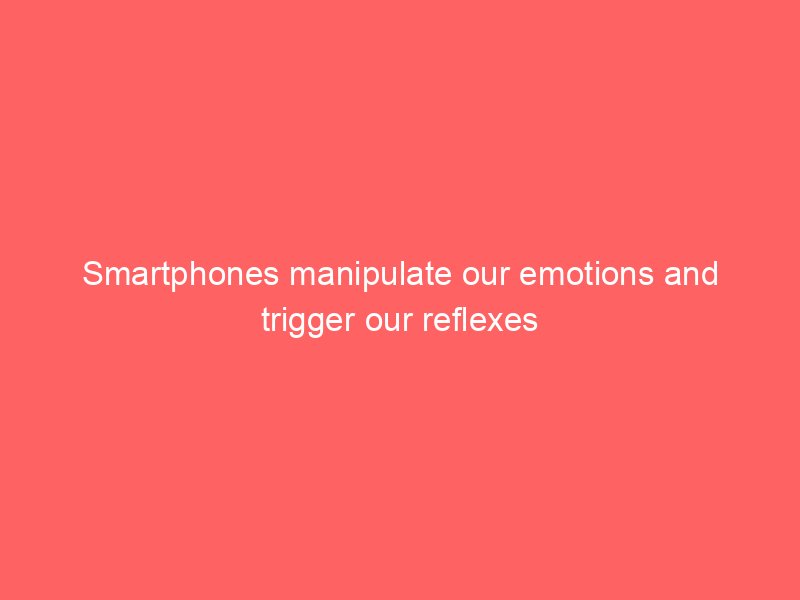Your cart is currently empty!

The frequency and length of daily phone use continues to rise, especially among young people. It’s a global concern, driving recent decisions to ban phones in schools in Canada, the United States and elsewhere.
Read more: School smartphone bans reflect growing concern over youth mental health and academic performance
Social media, gaming, streaming and interacting with AI chatbots all contribute to this pull on our attention. But we need to look at the phones themselves to get the bigger picture.
As I argue in my newly published book, Needy Media: How Tech Gets Personal, our phones — and more recently, our watches — have become animated beings in our lives. These devices can build bonds with us by recognizing our presence and reacting to our bodies.
Packed with a growing range of technical features that target our sensory and psychological soft spots, smartphones create comforting ties that keep us picking them up. The emotional cues designed into these objects and interfaces imply that they need our attention, while in actuality, the devices are soaking up our data.
Face recognition, geolocation, touchscreens, vibration, sound alerts and audio and motion sensing all play their part in catching our attention and responding to our actions. Separately, these may not create a strong emotional attachment, but collectively they situate the phone as a uniquely intimate, sensitive and knowing presence in our lives.
Take facial recognition locks, for example. Convenient for quick access, a smartphone will light up and unlock with a glance when it encounters a known and trusted face. When introducing Face ID in 2017, Apple claimed: “Do it up anyway you do it, Face ID learns your face. It learns who you are.” This implies a deeper user-device connection, like the one we have with folks we know when we spot them crossing our path.
Some devices have repurposed the hand wave — a typical gesture of friendship — into a feature that triggers the camera to take a photo.
Geolocation converts networking signals into a dot on a map, and we see that dot as us — not our phone — just as we may see the dots of our friends’ phones on the map as them.
Sensory cues play a strong role. Touchscreens allow the phone’s interface to react subtly, like edge lighting and rubberbanding, to mimic the pliability of skin.
Vibration and sound alerts make us highly sensitive to the smallest movement or sound from the device. This produces conditions like phantom vibration syndrome, where we imagine that the device requires our attention, even when it doesn’t.
Audio and motion sensing, on the other hand, allows the device to react to us almost instantly, as when it lowers its ringing on an incoming call when we grab its body.
Vibration alerts were created for pagers in the late 1970s for professionals — from hospital staff to travelling salespeople — to notify them of an important phone call.
Sound alerts became more widespread with Tamagotchi and other 1990s digital pets. Those toys are especially significant when discussing today’s psychological dependency on portable devices.
Through their beeping cries for attention, Tamagotchi trained millions of school-age millennials to build emotional attachments to virtual handheld companions needing care and nurturing. Not surprisingly, these toys were banned in many schools for their tendency to disrupt classes and distract students.
Sleep is a good example. Audio and motion sensing allows the device to get a reasonable picture of when and how we sleep, often collecting and sharing biometric data through pre-loaded health and wellness apps.
Another example is more sophisticated facial recognition, that will not only be able to recognize a face, but also analyze expressions to determine alertness or mood.
All of this collected data may have profound consequences, making our bodily behaviour, our off-line interactions with others and our emotional fragility a regular part of the data profiles used to leverage our lives for corporate profit.
Short of powering off or walking away, what can we do to manage this dependency? We can access device settings and activate only those features we truly require, adjusting them now and again as our habits and lifestyles change.
So-called “dumb phones” limit what a user can do with their devices, though that’s a tough sell when 24/7 connectivity is becoming an expectation.
In the meantime, at a minimum, we should broaden our public discussions of dependency beyond social media, gaming and artificial intelligence to acknowledge how phones, in themselves, can capture our attention and cultivate our loyalty.
Smartphones Listen to this article
Smartphones capture our attention and cultivate our loyalty. (Getty Images/Unsplash+)
Hello,
This is xdefiance

Welcome to the website, my cozy corner of the internet dedicated to all things homemade and found delightful to share with others online and off.
You can book with Jeffrey, Founder of xdefiance.com, by following this link here.
Visit the paid digital downloads products page to see what is all available for immediate purchase & download to your computer or cellphone by clicking this link here.
Find out more about xdefiance.com by reading the FAQ for answers to common questions. Read the Returns & Exchanges Shop Policy and if you have any questions, please contact during business hours:
Mon.-Fri. 9am-5pm, Sat. 10am-5pm Sun. Closed
You can reach someone directly at 419-318-9089 or send an email to shop@xdefiance.com for a response will be given usually within 24 hours of receiving it.
Let’s connect
Join the fun!
Stay updated with our latest tutorials and ideas by joining our newsletter.





Leave a Reply
You must be logged in to post a comment.